Ring sizing is essential for ensuring a perfect fit, combining comfort and style. Proper measurement methods, like using a ring sizer or string, help determine accurate sizes. Always measure in the evening for the best fit, as fingers vary in size throughout the day. Avoid measuring when cold, as this can result in a smaller size. Use a ring size chart to match your measurement for the ideal fit, ensuring your jewelry feels comfortable and looks great.
Importance of Accurate Ring Sizing
Accurate ring sizing ensures a perfect balance of comfort and functionality. A well-fitting ring avoids discomfort and premature wear. Measuring correctly prevents the need for costly resizing. Avoid measuring when cold, as fingers shrink, leading to tighter fits. Ideal measurements occur in the evening, as fingers tend to swell slightly during the day. Incorrect sizing can result in a ring that is too tight, restricting movement, or too loose, risking loss. Proper sizing enhances the ring’s appearance and ensures it stays securely in place. Always use a ring size chart or professional tools for precise measurements. This guarantees a flawless fit, whether for everyday wear or special occasions.
Overview of Ring Size Charts
Ring size charts are essential tools for determining the perfect fit. They provide a standardized guide, correlating finger measurements with corresponding ring sizes. These charts typically include measurements in millimeters or inches, along with numerical or alphabetical size designations. To use a chart, measure the internal diameter of an existing ring or the circumference of the finger. Place the ring on the chart or compare the measurement to the size guide. Accurate sizing ensures comfort and prevents the need for resizing. Charts vary by region, so it’s important to use one that matches your location. Always measure in the evening for the most accurate fit, as fingers can swell during the day. Consulting a professional jeweler is recommended for precise results, especially for engagement or special-occasion rings.
Understanding Ring Size Charts
Ring size charts are tools that help match finger measurements to ring sizes. They use millimeters or inches to determine the best fit. Charts vary by region, so it’s important to use one that matches your location. Accurate measurements ensure comfort and proper fit, avoiding resizing. Always measure in the evening for the most accurate results, as fingers can swell during the day. Consulting a professional jeweler is recommended for precise results, especially for engagement or special-occasion rings.
Standard Ring Size Measurements
Standard ring size measurements are based on the internal diameter or circumference of the ring. In most countries, sizes are expressed in numbers or letters, such as US (4-16) or EU (42-68). To determine size, measure the finger or an existing ring. For accuracy, use a ruler or tape measure to find the internal diameter in millimeters, then match it to a size chart. Regional differences exist, so ensure the chart aligns with your location. For example, a size 6 in the US is equivalent to an 18mm diameter. Always measure in the evening, as fingers swell slightly during the day. Avoid measuring when cold, as this can result in a smaller size. Consulting a professional jeweler ensures precise results, especially for engagement or special-occasion rings.
Regional Differences in Ring Sizing
Ring sizing varies across regions, with different systems used worldwide. In the US, sizes range from 4 to 16, while Europe uses diameters in millimeters (e.g., 42-68). Some countries, like the UK, use letters (A-Z). These differences can lead to confusion when purchasing internationally. For example, a size 6 in the US is equivalent to a 16mm diameter, which may not align with other regions. Always use a ring size chart specific to your region to ensure accuracy. Online retailers often provide charts tailored to their target market. Be aware of these variations to avoid sizing errors, especially when shopping across borders or online. Using a local jeweler or printable guide can help confirm your size accurately.
How to Read a Ring Size Chart
Reading a ring size chart involves matching your finger or ring measurements to the corresponding size. Start by measuring the internal diameter of the ring in millimeters or the circumference of your finger. Locate the measurement on the chart, which typically lists sizes numerically or alphabetically. Ensure the chart is specific to your region, as sizing systems vary. For example, a 16mm diameter corresponds to a US size 6. If using a printable guide, place the ring on the chart to find the best fit. Consider the ring’s width, as wider bands may require a larger size. Always measure in the evening for accuracy, as fingers can swell during the day. This method ensures a comfortable and precise fit for any occasion.
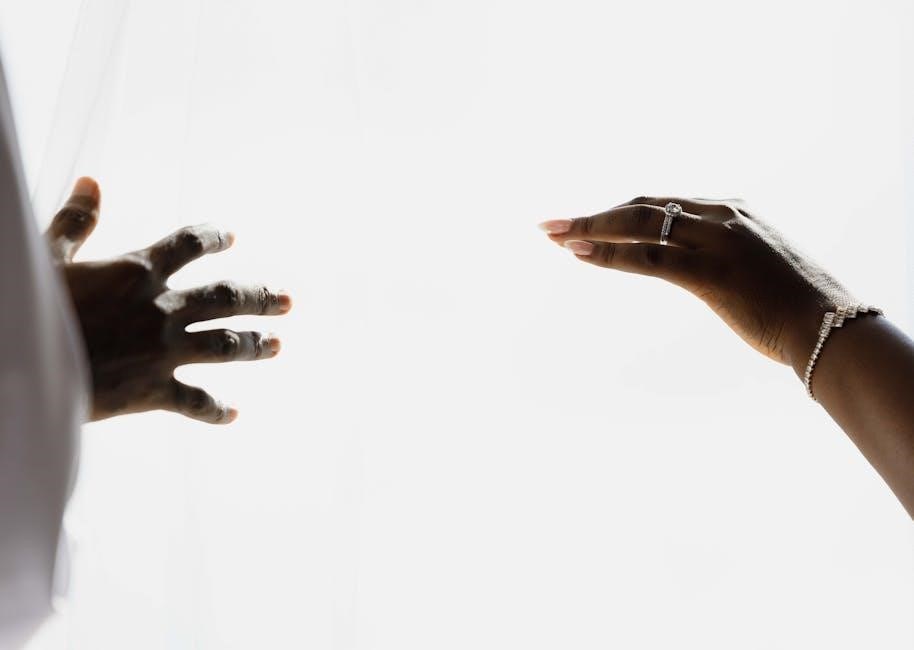
Methods for Measuring Ring Size

Common methods include using a ring sizer tool, the string or paper technique, or measuring an existing ring. Each ensures accurate sizing for a perfect fit.
Using a Ring Sizer Tool
A ring sizer tool is a convenient and accurate method to determine your ring size. Simply place the tool on your finger, ensuring it fits comfortably. The tool typically features numbered slots, allowing you to identify your size based on where the tool stops. For the best results, measure in the evening, as fingers tend to swell slightly during the day. Avoid measuring when your hands are cold, as this can lead to a smaller size. The tool is designed to mimic the feel of an actual ring, ensuring a precise fit. By using a ring sizer, you can confidently select the right size for your jewelry, whether for everyday wear or a special occasion.
String or Paper Method
The string or paper method is a simple and effective way to measure your ring size at home. Cut a strip of paper or use a string, wrapping it around the base of your finger where the ring will sit. Mark the point where the paper or string overlaps with a pen. Lay the strip flat and measure the length in millimeters using a ruler. Compare this measurement to a ring size chart to find your corresponding size. For accuracy, ensure the paper or string is snug but not too tight. This method is ideal for those without access to a ring sizer tool, providing a reliable way to determine your ring size comfortably and conveniently at home.
Measuring an Existing Ring

To measure an existing ring, place it on a ruler or use a ring sizer tool. Measure the internal diameter of the ring in millimeters. Compare this measurement to a ring size chart to determine the corresponding size. For the most accurate results, ensure the ring is placed flat and the measurement is taken from edge to edge. Avoid measuring rings with unique shapes or wide bands, as they may not fit standard sizing charts. This method is ideal for replicating a ring you already know fits well. Always measure in the evening, as fingers tend to be slightly larger at this time, ensuring the best fit.
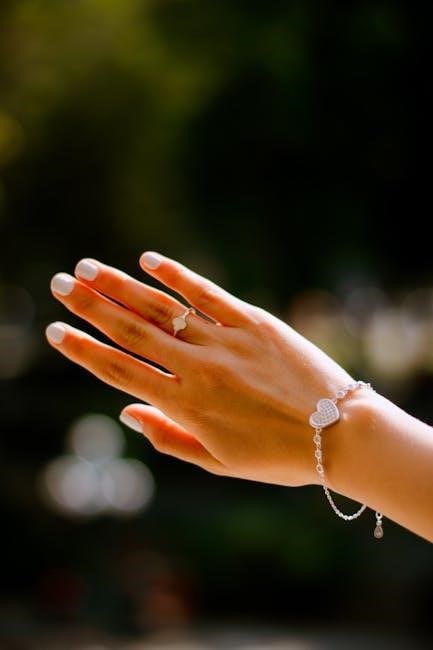
Factors Affecting Ring Size
Temperature, weight fluctuations, and finger shape significantly impact ring size. Cold temperatures can shrink fingers, while heat causes swelling. Weight changes alter finger circumference, and unique finger shapes may require different sizing approaches for a comfortable fit.
Temperature and Its Impact
Temperature plays a crucial role in determining ring size. In colder conditions, fingers tend to shrink, which can make a ring feel looser and potentially lead to a smaller size measurement. Conversely, heat causes fingers to swell, making rings feel tighter. This fluctuation can result in varying measurements throughout the day. To ensure accuracy, it’s best to measure ring size in the evening when body temperature is more stable. Avoid measuring when hands are excessively cold or hot, as this can lead to incorrect sizing. Understanding this temperature-related variability helps in choosing the right fit for comfort and security.
Weight Fluctuations
Weight changes can significantly impact ring size, as they affect finger circumference. Gaining or losing weight may cause fingers to enlarge or shrink, altering the fit of a ring. Even small fluctuations can make a ring feel tighter or looser over time. For accurate sizing, consider your average weight and measure during a stable period. If weight changes are substantial, it may be necessary to adjust the ring size. Keep in mind that weight fluctuations are a natural part of life, so regular monitoring of fit is essential. Consulting a jeweler for resizing options can ensure long-term comfort and satisfaction with your ring.
Finger Shape and Size
Finger shape and size play a crucial role in determining the perfect ring fit. Some individuals have larger knuckles, while others have slender fingers, which can affect how a ring sits. For those with prominent knuckles, it’s essential to ensure the ring can slide past the knuckle comfortably. Measure the finger at its widest point to accommodate the ring’s movement. Finger shape can also influence the choice of ring style, as certain designs may suit specific finger types better. Consider the natural curves and proportions of the finger to ensure the ring feels comfortable and looks balanced. This ensures a seamless fit tailored to individual anatomy.
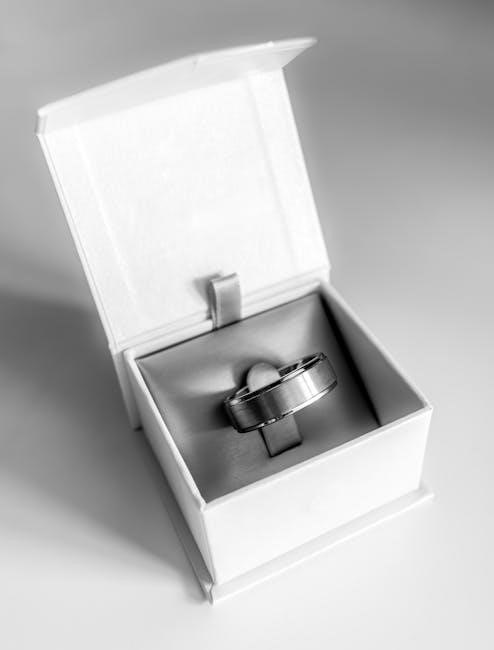
Choosing the Right Ring Size
Selecting the correct ring size ensures comfort and style. Measure accurately, considering factors like temperature and weight changes. Use a ring size chart for precise fitting, ensuring the ring is neither too tight nor too loose. Opt for a size that allows easy movement while staying secure. Proper sizing enhances both appearance and wearability, making the ring a perfect fit for any occasion.
Tips for First-Time Buyers
For first-time buyers, accurate ring sizing is crucial for a perfect fit. Start by measuring your finger when it’s at a stable temperature, as size can vary. Use a printable ring sizer or visit a jeweler for precise measurement. Consider weight fluctuations and finger shape, as these can affect size. If unsure, opt for a slightly larger size to ensure comfort. Measure multiple times and consult a ring size chart for consistency. Avoid guessing, as it may lead to an ill-fitting ring. Don’t hesitate to seek professional guidance for engagement or fashion rings. Proper sizing ensures the ring feels comfortable and looks great, making it a worthwhile investment.
Measuring for Different Occasions
Measuring for different occasions ensures the perfect fit for any event. For formal events, consider a slightly tighter fit to prevent the ring from slipping during activities. For casual wear, a more relaxed fit may be preferable. Measure your finger in the evening, as it tends to be at its largest. Avoid measuring when cold, as fingers can shrink by half a size. Use a ring size chart to match your measurement accurately. If purchasing for a gift, measure the recipient’s finger discreetly or use an existing ring as a guide. Proper sizing ensures comfort and confidence, making the ring suitable for any occasion.
Considerations for Engagement Rings
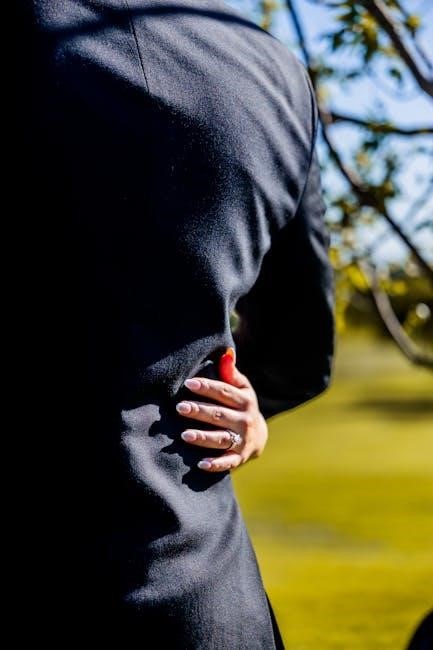
Engagement rings hold sentimental value, making accurate sizing crucial. Measure in the evening when fingers are largest, as sizes can vary throughout the day. Avoid measuring when cold, as fingers may be smaller. Consider the ring’s width and style, as thicker bands may require a slightly larger size. If the ring is a surprise, measure discreetly or use an existing ring as a guide. Avoid guessing sizes, as this can lead to discomfort or resizing needs. Use a ring size chart to ensure precision, and consider professional sizing for the best fit. Some jewelers offer resizing options, providing flexibility for future adjustments.

Considerations for Fashion Rings
Fashion rings are a stylish accessory, but proper sizing is key for comfort and aesthetics. Measure your finger in the evening for accuracy, as sizes can fluctuate. Use a ring sizer or string method to determine your size, ensuring the ring sits comfortably without slipping off. Consider the ring’s width and style, as thicker bands may require a slightly larger size. Check the size chart to match your measurement precisely. If unsure, consult a jeweler for professional sizing. Proper fit ensures the ring enhances your look without causing discomfort. Remember, fashion rings should complement your style while feeling effortless to wear.
Common Mistakes to Avoid
Measuring at the wrong time, ignoring ring width, and not considering finger shape are common errors. Measure in the evening and use a size chart for accuracy.
Measuring at the Wrong Time
Measuring your ring size at the wrong time can lead to inaccurate results. Fingers naturally swell or shrink throughout the day due to temperature, activity, and hydration levels. Avoid measuring when your hands are cold, as this can result in a smaller size. Conversely, measuring after intense activity or in hot conditions may cause your fingers to be larger. The best time to measure is in the evening when your body temperature is stable. Additionally, avoid measuring when you’re sick or experiencing water retention, as this can temporarily alter your finger size. For the most accurate fit, measure at a neutral time to ensure your ring size reflects your typical finger size. Consistency is key to avoiding sizing errors.
Not Considering Ring Width
Ring width significantly impacts the fit, yet it’s often overlooked. Wider rings may feel tighter due to the increased surface area on the finger, while narrower rings may feel looser. For example, a size 6 ring with a 6mm width might feel snug, while the same size with a 4mm width could feel more comfortable. Always consider the ring’s width when selecting a size, as it can affect how the ring sits on the finger. A wider ring may require a larger size for comfort, while a narrower ring might fit true to size. Neglecting this factor can lead to a ring that’s either too tight or too loose, compromising both comfort and appearance. Always consult a sizing chart that accounts for ring width to ensure the best fit.
Ignoring Finger Shape
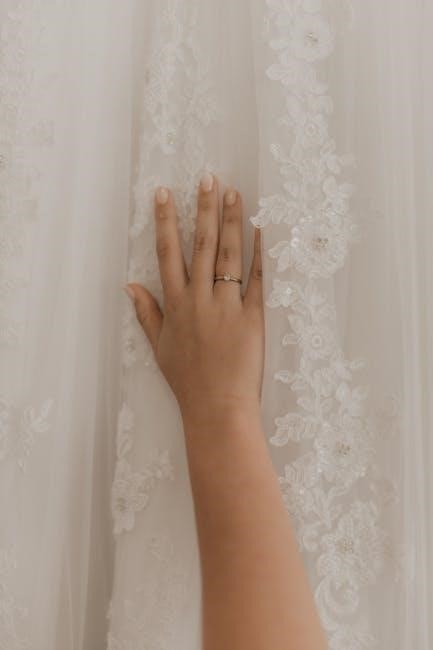
Finger shape plays a crucial role in determining the perfect ring fit. Individuals with larger knuckles or more rounded fingers may require a slightly larger size to ensure comfort and ease of movement. Conversely, those with slender or elongated fingers might prefer a more secure fit to prevent the ring from slipping off. Ignoring finger shape can lead to discomfort or a ring that doesn’t sit properly. For example, a ring that fits well on a narrower finger may feel too tight on a wider one. Always consider the natural contours of the finger when selecting a size to ensure the ring is both comfortable and visually flattering. Proper sizing accounts for both measurement and finger shape for the best results.

How to Use a Ring Size Chart
Using a ring size chart ensures accurate sizing. Measure the internal diameter of the ring in millimeters and compare it to the chart. Consider finger shape for a perfect fit.
Matching Measurements to Sizes
Matching measurements to sizes is crucial for a perfect fit. Measure the internal diameter of the ring in millimeters and compare it to the chart. For example, a 16mm diameter corresponds to a size 6. If your measurement falls between sizes, opt for the larger size. Consider the ring’s width, as wider rings may require a larger size for comfort. Use a ring sizer tool or a printable guide to ensure accuracy. Always measure in the evening, as fingers tend to swell during the day. This method ensures your ring fits comfortably and securely, avoiding the need for resizing.
Interpreting the Chart
Interpreting a ring size chart involves understanding how measurements translate to sizes. Start by measuring the internal diameter of the ring in millimeters or the circumference of the finger. Use the chart to find the corresponding size. For example, a 16mm diameter matches a size 6, while a 46mm circumference corresponds to a size 9. If your measurement falls between sizes, choose the larger size for comfort. Consider factors like temperature and weight fluctuations, as these can affect fit. Always measure in the evening, as fingers tend to swell slightly during the day. This ensures the ring fits securely without being too tight or too loose.
Troubleshooting Ring Fit
If a ring is too tight, consider resizing or adjusting the band. For a loose ring, resizing or adding sizing beads can ensure a secure fit.
What to Do If the Ring Is Too Tight
If a ring feels too tight, it may cause discomfort or restrict blood flow. To address this, consider professional resizing or adjusting the band. Avoid forcing the ring over the knuckle, as this can cause damage. Instead, visit a jeweler to assess the best solution. Resizing is often the most reliable option, ensuring a comfortable fit without compromising the ring’s integrity. Additionally, wearing the ring during cooler parts of the day can provide temporary relief, as fingers tend to be slightly smaller. Prioritizing a proper fit ensures both comfort and longevity of the ring.
What to Do If the Ring Is Too Loose
If a ring is too loose, it may slip off easily, posing a risk of loss. To address this, consider resizing the ring to a smaller size or using a ring guard to secure it. Adjusting the band or adding sizing beads can also provide a snugger fit. For temporary solutions, wearing the ring on a different finger or using a silicone ring adjuster can help. However, for a permanent fix, consulting a jeweler is recommended to ensure proper resizing without damaging the ring. Regularly checking the fit and making adjustments as needed can prevent the ring from becoming too loose over time.
Conclusion
Proper ring sizing ensures comfort, style, and security. Accurate measurements and the right tools guarantee a perfect fit, making your jewelry a lasting and enjoyable accessory.
Final Tips for Perfect Fit
Achieving the perfect ring fit requires careful consideration. Always measure in the evening, as fingers tend to swell during the day. Avoid sizing when hands are cold, as this can lead to a smaller fit. Use a ring sizer tool or the string method for accuracy. If unsure, opt for the larger size to ensure comfort. Consider the ring’s width, as wider bands may require a slightly larger size. Regularly check your ring size, as it can change over time due to weight fluctuations or other factors. Proper sizing ensures your ring is both comfortable and secure, enhancing your overall satisfaction.
Importance of Proper Sizing
Proper ring sizing is crucial for both comfort and aesthetics. A well-fitting ring ensures optimal wearability, preventing discomfort or restricted blood flow. It also enhances the ring’s appearance, as a correctly sized ring sits evenly on the finger. Improper sizing can lead to a ring that is too tight, causing discomfort, or too loose, risking loss. Additionally, proper sizing avoids the need for costly resizing, which may alter the ring’s design. Accurate sizing is especially vital for engagement rings, where emotional and financial investments are high. Ensuring the right fit guarantees a ring that is both functional and meaningful, making it a lasting treasure.
Frequently Asked Questions
Common questions include how often to measure ring size, whether size changes over time, and the best methods for accurate sizing. Answers ensure a perfect fit.
How Often Should I Measure My Ring Size?
It’s recommended to measure your ring size periodically, as factors like weight changes, temperature, and finger shape can affect size. Measure every 6-12 months for accuracy. Factors such as weight gain or loss, pregnancy, and aging can cause size fluctuations. Additionally, measuring at different times of day, especially in the evening, ensures the best fit. Avoid measuring when hands are cold, as this can result in a smaller size. For optimal comfort, consider seasonal changes, as fingers may swell in heat or shrink in cold. Regular measurements help maintain the perfect fit, ensuring your ring feels comfortable and secure. Always use a reliable method or tool for accurate results.
Can Ring Size Change Over Time?
Yes, ring size can change over time due to various factors. Weight fluctuations, whether gain or loss, can alter finger size. Temperature also plays a role, as fingers swell in heat and shrink in cold. Additionally, natural changes in finger shape and size due to aging or medical conditions can affect fit. Pregnancy and hormonal shifts are other factors that may cause size changes. It’s important to measure regularly, especially after significant life events, to ensure a comfortable fit. While rings can be resized, understanding these changes helps in making informed decisions when purchasing or adjusting jewelry. Regular monitoring ensures your ring remains a perfect fit over the years.
